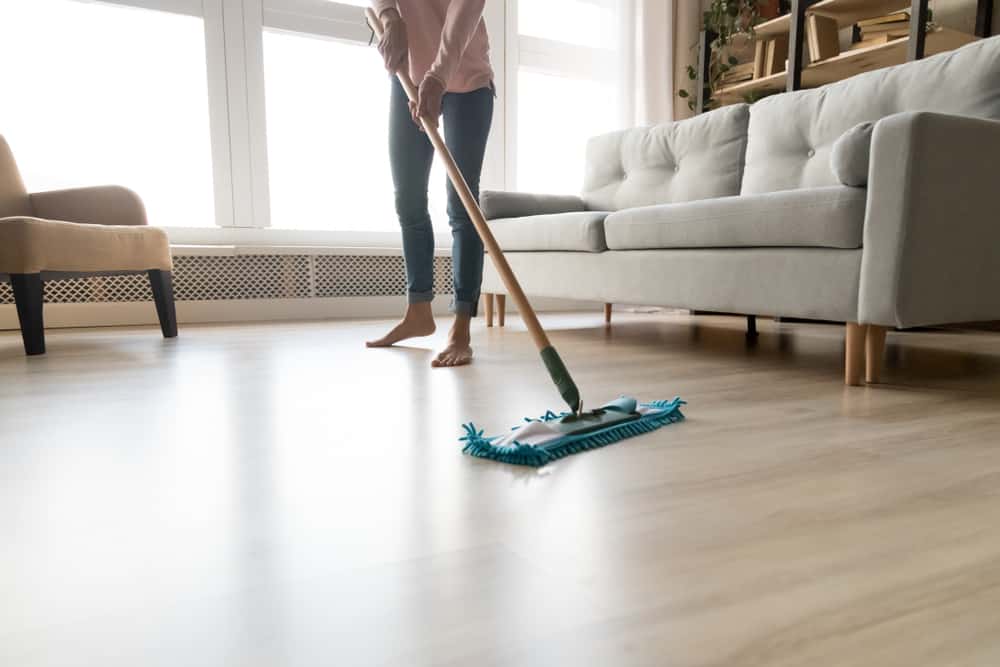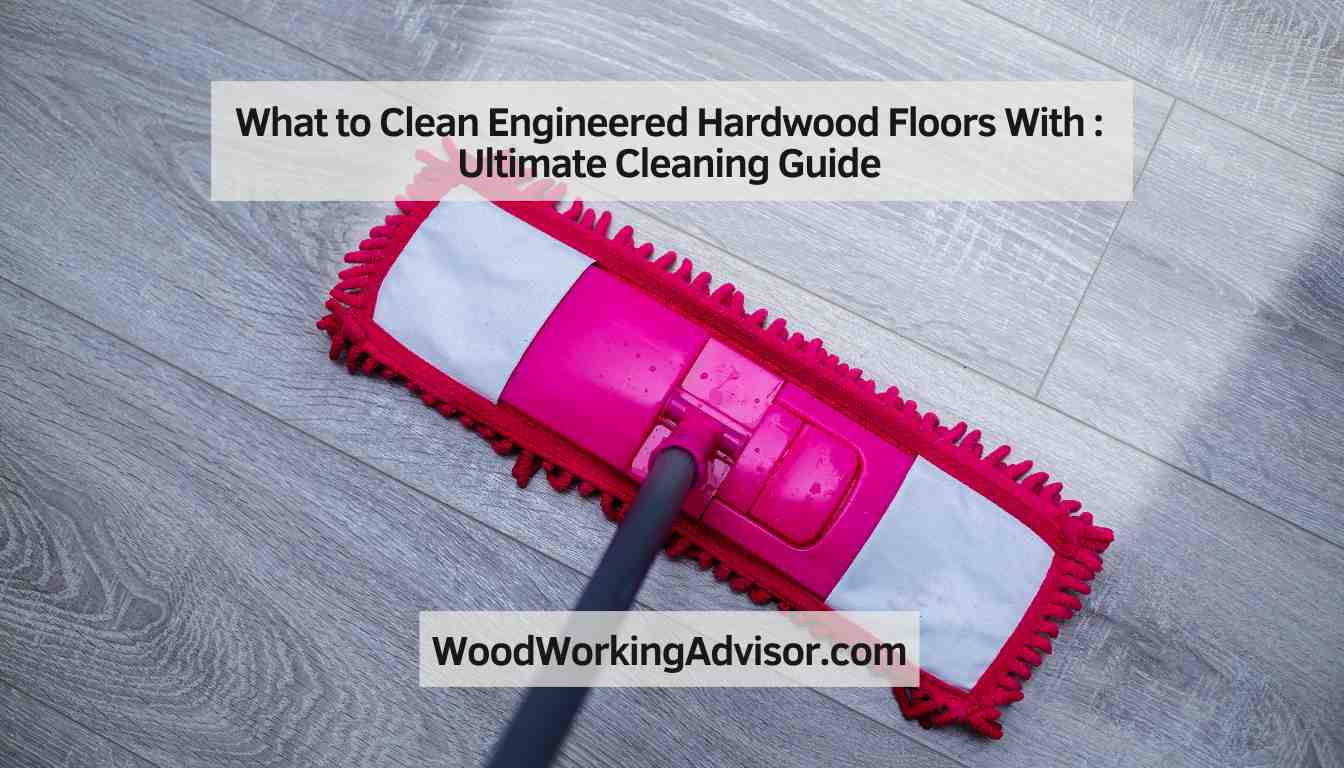To clean engineered hardwood floors, use a pH-neutral cleaner recommended by the manufacturer for best results. Avoid using excess water during cleaning to prevent damage to the wood.
It is essential to follow the manufacturer’s guidelines carefully to maintain the beauty and longevity of your engineered hardwood floors effectively. Taking care of your engineered hardwood floors is crucial to preserving their appearance and durability. By using the right cleaning products and methods, you can keep your floors looking their best for years to come.
We will explore the best practices for cleaning engineered hardwood floors to ensure they remain in top condition.

Credit: wideplankflooring.com
Choosing The Right Cleaning Products
Understanding The Composition Of Engineered Hardwood Floors
Engineered hardwood floors consist of multiple layers of wood veneer over a plywood base.
Prohibited Cleaning Products
- Avoid harsh chemicals: such as ammonia, bleach, or vinegar that can damage the floor’s finish.
- Stay away from steam cleaners: excessive moisture can cause warping or swelling of the floor.
- Say no to abrasive tools: like steel wool or scouring pads that can scratch the surface.

Credit: parryscarpets.com.au
Daily Cleaning Routine
Sweeping And Vacuuming
Use a soft-bristle broom or vacuum with a hardwood floor attachment to remove dirt and debris daily.
Damp Mopping
Damp mop using a well-wrung mop with a pH-neutral hardwood floor cleaner to maintain cleanliness.
Dealing With Stubborn Stains
Engineered hardwood floors can be a beautiful addition to any home, but stubborn stains can be a challenge to deal with. To clean them effectively, use a gentle cleaner specifically designed for engineered hardwood floors, and avoid harsh chemicals or abrasive cleaning tools.
Identifying Different Types of Stains
When facing stubborn stains on engineered hardwood floors, it’s crucial to begin by identifying the different types of stains. Common stains include food, grease, ink, water, and pet stains. Each type of stain may require a specific approach for effective removal.
Techniques for Stain Removal
Now that you’ve identified the type of stain, it’s time to employ the most effective techniques for removal. For food and grease stains, create a paste using baking soda and a small amount of water to gently scrub the affected area. Ink stains can often be removed with a cloth soaked in rubbing alcohol, while water stains may require a mixture of equal parts vinegar and water applied with a damp cloth. For pet stains, consider an enzyme-based cleaner designed for hardwood floors.
Engage the affected area with a soft, clean cloth and gentle pressure. In instances where the stain persists, consult the manufacturer’s recommendations or seek professional assistance.
Long-term Maintenance
For long-term maintenance of engineered hardwood floors, it’s important to use a pH balanced, gentle cleaner specifically designed for this type of flooring. Look for products recommended by the manufacturer, and avoid using harsh chemicals or excessive water when cleaning.
Regularly vacuuming or sweeping to remove dirt and debris can also help maintain the floors’ appearance.
Regular cleaning and maintenance are essential in ensuring the longevity of your engineered hardwood floors. While daily cleaning takes care of the immediate dirt and spills, long-term maintenance involves additional steps to keep your floors looking their best for years to come. In this section, we will discuss two important aspects of long-term maintenance: refinishing and recoating, as well as protective measures to prevent damage.
Refinishing And Recoating
Over time, engineered hardwood floors may start to show signs of wear and tear such as scratches and dullness. Refinishing and recoating are effective ways to restore the beauty and shine of your floors.
Refinishing involves sanding down the top layer of the floor to remove any imperfections. This process requires professional help and is recommended when the damage is extensive. After sanding, a new protective layer and finish are applied, leaving your floors looking brand new. Refinishing can be a costly and time-consuming process but is necessary in cases where the damage is beyond normal wear and tear.
Recoating, on the other hand, is a simpler and less expensive option for maintaining your floors. It involves applying a fresh coat of finish to the surface, providing an extra layer of protection and enhancing the appearance of the wood. Recoating is suitable for floors that have minor scratches or signs of wear. It can be done by homeowners themselves using specially formulated products, making it a convenient and budget-friendly option.
Protective Measures
Prevention is always better than cure when it comes to maintaining your engineered hardwood floors. By implementing some protective measures, you can extend the lifespan and minimize the need for refinishing or recoating.
1. Mats and rugs: Place mats or rugs at entryways and high-traffic areas to prevent dirt, sand, and debris from being tracked onto your floors. This simple step can significantly reduce the chances of scratches and abrasions.
2. Furniture pads: Attach felt or rubber pads to the legs of your furniture to prevent them from scratching the floor when moved or dragged. These pads create a buffer between the furniture and the floor, minimizing damage.
3. Avoid excess moisture: While engineered hardwood floors are more resistant to moisture than solid wood floors, it’s still important to clean up spills promptly and avoid excessive moisture. Wipe up any liquid spills immediately and use a damp, not wet, mop for regular cleaning.
4. Regular sweeping and vacuuming: Regularly sweeping or vacuuming your floors will help remove dirt, dust, and debris that can cause scratches over time. Use a soft-bristle broom or a vacuum cleaner with a floor attachment to avoid scratching the surface.
By following these long-term maintenance tips, you can keep your engineered hardwood floors looking beautiful and pristine for years to come. Remember to consult your manufacturer’s guidelines for specific cleaning products and techniques to ensure the best care for your particular type of flooring.

Credit: www.flooringinc.com
Frequently Asked Questions On What To Clean Engineered Hardwood Floors With
What Is The Best Way To Clean Engineered Wood Floors?
To clean engineered wood floors, use a damp mop with a pH-neutral cleaner. Avoid excess water and harsh chemicals. Regularly sweep or vacuum to remove dirt and debris. Wipe up spills promptly and never use steam cleaners.
Is Bona Safe For Engineered Hardwood Floors?
Yes, Bona is safe for engineered hardwood floors as it is specifically formulated for use on this type of flooring.
How Do You Maintain Engineered Wood Floors?
To maintain engineered wood floors, clean regularly with a dry mop or vacuum to remove dirt and debris. Use a damp mop for deeper cleaning, but avoid excessive water. Wipe spills immediately and use protective pads on furniture legs to prevent scratching.
Lastly, avoid using harsh chemicals.
How Do You Make Engineered Hardwood Floors Shine?
To make engineered hardwood floors shine, start by regularly dusting and sweeping to remove dirt and debris. Then, use a pH-neutral cleaner and a damp mop to gently clean the floors. Avoid excessive water or harsh chemicals as they can damage the wood.
Finally, apply a wood floor polish to restore and enhance the shine.
Conclusion
Keeping your engineered hardwood floors clean is crucial for their longevity and appearance. By using the right cleaning products and techniques, you can maintain their beauty and charm for years to come. With proper care, your floors will continue to enhance the aesthetic appeal of your home.


